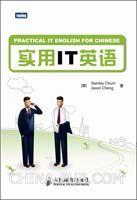內容簡介
本書是面向中國it人士的英語培訓教材。它針對中國人學習英語多年,已具備一定基礎的特點,力圖通過大量模擬實際it環境的訓練輔以正確的方法,讓讀者能夠輕鬆用英語交流。全書通篇用英文寫成,利於營造英語氛圍,培養語感,更體現本書“用英文思考”的主線。前4章,每頁英文後附對應的中文翻譯,供英文閱讀有困難的讀者參考。
本書實用性強,可作為企業的培訓教材,也可供大專院校計算機系及it相關專業的學生使用,作為自學教材亦是不錯的選擇。
作者
覃伯淇 獲英國伯明罕大學計算機與通信工程專業博士學位,具有25年在美國、加拿大及歐洲企業工作的經驗,涉及領域包括計算機及通信產品的研發、項目管理、市場分析、產品管理、系統工程設計、網路設計、套用軟體開發、端對端的集成系統測試以及ISO 9000質量保障與審核等。 20世紀90年代初,曾作為聯合國發展項目(UNDP)專家幫助中國進行通信發展項目的策劃,並被聘為北京郵電大學的顧問教授。覃伯淇博土早期在美國服務過的企業有Sprint通信公司、GTE公司、南太平洋通信公司、太平洋貝爾公司。
程建群 獲美國夏威夷大學計算機科學專業碩士及博士學位,具有15年在美國、印度及中國企業工作的經驗,涉及領域包括計算機及通信軟體的設計和開發、市場分析、系統工程管理技術等,服務過的美國企業包括Sprint通信公司及Starvox公司。程建群博士近期擔任信息產業部軟體與積體電路促進中心國家軟體外包人才培養項目管理中心主任、信息產業部軟體與積體電路促進中心中國軟體外包聯盟專家委員、北京比特華科技有限公司總裁、北京航空航天大學軟體學院軟體工程與管理專業主任及教授。
目錄
chapter 1 improving your english speaking processes 1
1.1 warm up with your most familiar topics 1
1.2 the translation process in speaking english 3
1.3 train your brain to think in english 9
1.3.1 training module 1: the simple arithmetic 9
1.3.2 training module 2: store and describe a picture in english 13
1.3.3 training module 3: tell a story in english 15
1.3.4 training module 4: listen to a topic and restate it in english 19
1.4 memorization in listening comprehension 23
1.4.1 the 5 ws 23
1.4.2 the two-tier memory 29
1.5 train your vocal system to speak english 35
1.5.1 guide 1: words and sentences 35
1.5.2 guide 2: short paragraphs 35
1.5.3 guide 3: voice volume 37
1.5.4 guide 4: speed 37
1.5.5 guide 5: speaking silently 37
1.5.6 guide 6: pause and breathing 37
1.5.7 guide 7: tone and emotion 39
1.6 meta-language 39
.1.7 sample training exercises 39
1.7.1 sample sentences 41
1.7.2 sample paragraphs 42
chapter 2 english necessity and practices for it professionals 51
2.1 practice your favorite topics in english 51
2.1.1 your company 51
2.1.2 your current work 57
2.2 information technology professions 61
2.2.1 computer hardware engineers 63
2.2.2 software engineers 63
2.2.3 it network specialists 65
2.2.4 applications researchers and developers 67
2.2.5 database administrators 67
2.2.6 web designers 69
2.2.7 technical support 69
2.3 global software outsourcing industry 71
2.3.1 what is“ outsourcing”? 71
2.3.2 what can be outsourced ? 73
2.3.3 application development and maintenance (adm) 73
2.3.4 business process outsourcing (bpo) 73
2.3.5 why do companies outsource ? 75
2.3.6 types of outsourcing projects 79
2.3.7 language barrier 81
2.3.8 documentation barrier 83
2.4 daily tasks of an it professional 85
2.4.1 example a: asking for help 87
2.4.2 example b: providing technical support to a
customer enquiry 89
2.5 mastering the it terminology 93
chapter 3 communications in english 95
3.1 attributes of a communications session 95
3.2 environment 97
3.2.1 languages mix 99
3.2.2 direction 99
3.2.3 distance 99
3.2.4 timing 101
3.2.5 media and facility 101
3.2.6 culture, terminology and jargon 101
3.2.7 degree of attention and focus 103
3.2.8 classroom experiment 103
3.3 participants 105
3.3.1 relationship 107
3.3.2 ranking 107
3.3.3 background 107
3.4 purposes 107
3.5 substances 109
3.6 motivations 109
3.7 managing the stage 109
chapter 4 speaking english at work 113
4.1 speaking versus listening 113
4.2 rating your concerns when you speak 115
4.3 presentation versus conversation 117
4.3.1 presentation 117
4.3.2 conversation 119
4.4 conversation techniques 121
4.4.1 knowing the people and call them by names 123
4.4.2 speak clearly and slowly 125
4.4.3 speak with appropriate loudness 125
4.4.4 speak with enthusiasm 125
4.4.5 your posture and positioning 127
4.4.6 use eye contact 129
4.4.7 use gestures 129
4.4.8 use facial expression 131
4.4.9 use movements 131
4.4.10 use active voice 131
chapter 5 practical case practices 133
5.1 introducing yourself 134
5.2 introducing others and being introduced 141
5.3 in the office and laboratory 148
5.4 talking about the products and services of your company 153
5.5 calling an engineer of the american source company 161
5.6 the american project manager calling 167
5.7 talking about the time zones 174
5.8 making a flight reservation 178
5.9 making an appointment 181
5.10 setting up a meeting 188
5.11 giving out and taking on a work assignment 193
5.12 explaining your source codes 201
5.13 explaining a test case 208
5.14 talking about team work 220
5.15 talking about software quality assurance (sqa) 226
appendix a english meta-language 235
appendix b it terminology 263
第 1 章 提升英語口語表達能力 2
1.1 從最熟悉的話題說起 2
1.2 說英語時的翻譯過程 4
1.3 訓練大腦用英語思考 10
1.3.1 訓練模組1:簡單的算術題 10
1.3.2 訓練模組2:用英語記憶和描述一幅畫面 14
1.3.3 訓練模組3:用英語講故事 16
1.3.4 訓練模組4:傾聽並複述 20
1.4 記憶傾聽時所能領會的 24
1.4.1 “五個w” 24
1.4.2 雙層記憶法 30
1.5 訓練自己的發聲系統習慣於說英語 36
1.5.1 建議1:單詞和句子 36
1.5.2 建議2:簡短的段落 36
1.5.3 建議3:音量 38
1.5.4 建議4:語速 38
1.5.5 建議5:默念 38
1.5.6 建議6:停頓與換氣 38
1.5.7 建議7:語調與感情 40
1.6 元語言 40
1.7 訓練例句及段落 40
1.7.1 例句 41
1.7.2 段落示例 42
第 2 章 it專業人員必備英語知識及練習 52
2.1 用英語練習你最感興趣的話題 52
2.1.1 你的公司 52
2.1.2 你現在的工作 58
2.2 信息技術領域的職業 62
2.2.1 計算機硬體工程師 64
2.2.2 軟體工程師 64
2.2.3 it 網路專家 66
2.2.4 套用研究和開發人員 68
2.2.5 資料庫管理員 68
2.2.6 web 設計師 70
2.2.7 技術支持人員 70
2.3 全球化軟體外包產業 72
2.3.1 什麼是“外包” 72
2.3.2 什麼可以外包 74
2.3.3 套用開發與維護(adm) 74
2.3.4 業務流程外包(bpo) 74
2.3.5 為什麼公司把事務外包出去 76
2.3.6 外包項目類型 80
2.3.7 語言障礙 82
2.3.8 文檔屏障 84
2.4 it 專業人士的日常工作 86
2.4.1 示例a:尋求幫助 88
2.4.2 示例b:為客戶諮詢提供技術支持 90
2.5 掌握信息技術術語 94
第 3 章 用英語溝通 96
3.1 溝通的構成因素 96
3.2 環境 98
3.2.1 語言組合 100
3.2.2 方向 100
3.2.3 距離 100
3.2.4 時機 102
3.2.5 媒介及設施 102
3.2.6 文化、術語和行話 102
3.2.7 注意力和集中度 104
3.2.8 課堂練習 104
3.3 參與者 106
3.3.1 關係 108
3.3.2 等級或輩份 108
3.3.3 背景 108
3.4 目的 108
3.5 內容 110
3.6 動機 110
3.7 有備而來 110
第 4 章 在工作中用英語交談 114
4.1 交談與傾聽 114
4.2 評定你交談時的顧慮 116
4.3 演講與交談 118
4.3.1 演講 118
4.3.2 交談 120
4.4 交談技巧 122
4.4.1 認識對方並稱呼他們的名字 124
4.4.2 慢慢地講清楚 126
4.4.3 使用適度音量 126
4.4.4 說話的激情 126
4.4.5 姿勢和定位 128
4.4.6 眼神接觸 130
4.4.7 使用手勢 130
4.4.8 使用面部表情 132
4.4.9 身體移動 132
4.4.10 使用主動語態 132
第 5 章 實際案例練習 133
5.1 介紹自己 134
5.2 介紹他人或者被人介紹 141
5.3 在辦公室和實驗室 148
5.4 淺談公司的產品和服務 153
5.5 與美國工程師通電話 161
5.6 美國的項目經理來電話 167
5.7 聊聊時差的問題 174
5.8 預定航班 178
5.9 預約 181
5.10 安排會議 188

